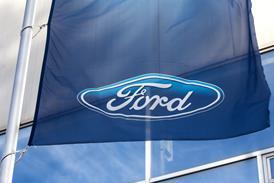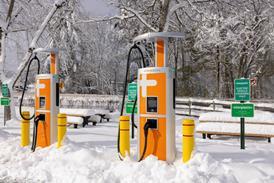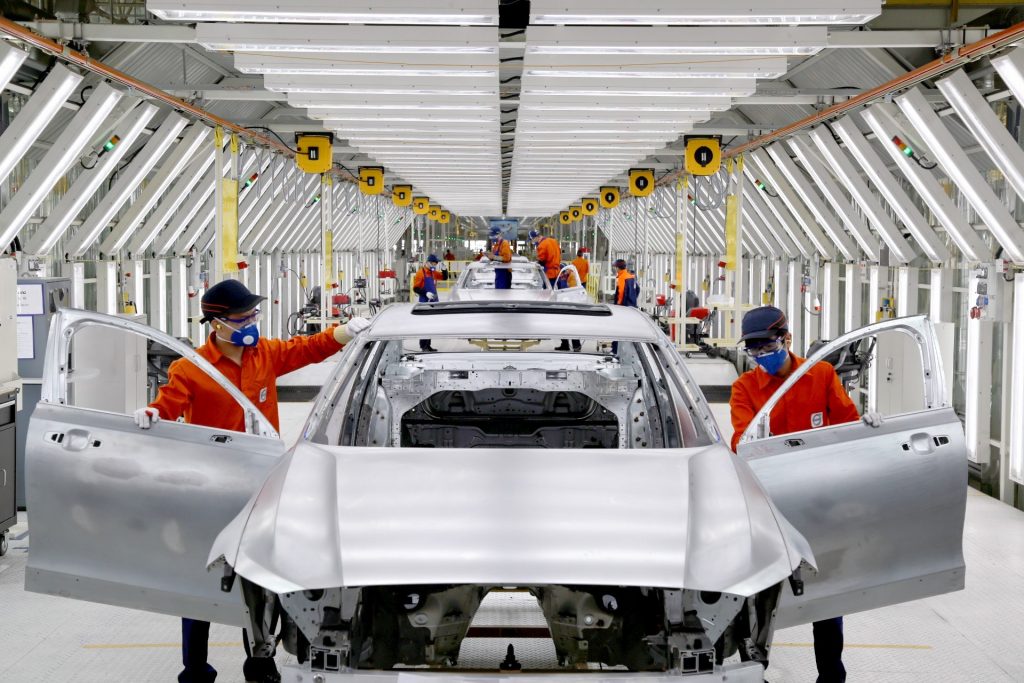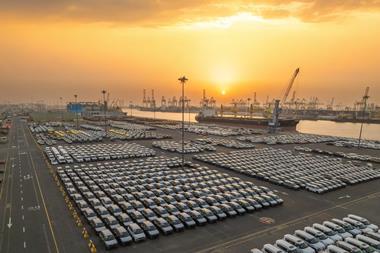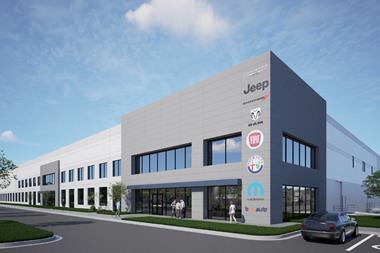[sta_anchor id="1"]Few carmakers have been moving as quickly as Volvo Cars to develop and expand their industrial footprint in China. In less than five years, the carmaker has launched two assembly plants and an engine factory, while ramping up production and more than doubling sales in the country. It has also begun exports of China-built products to western markets.
Last November, production of the premium S90 sedan began at the carmaker’s plant in Daqing, in north-east China, destined not only for local demand but also global markets; in June, shipments of the vehicle began to Europe, which will move by long-distance rail on a regular service – a first for Chinese-built cars.
The Geely-owned carmaker’s footprint in China will grow further this year. Production starts in summer at a new plant in Luqiao, south of Shanghai, which will build the all-new XC40 car, and models for Geely’s Lynk & Co brand. All the models built in Luqiao will be based on the compact modular architecture (CMA) that Geely and Volvo co-developed.
Alain Visser, senior vice-president of marketing, sales and service at Lynk & Co, said at the recent Shanghai motor show that the company would target exports to Europe in the first half of 2019, with exports to the US to follow later.
The next years will see complexity rise considerably. Volvo has said it will build its first fully electric vehicle in China, which will be based on the CMA and serve global markets.[in_this_story align="right" border="yes"]
If Volvo and Geely are confident in adding these important new sites and vehicles in quick succession, it is thanks in part to the stability and reliability of its supply chain for China. And that is despite having a logistics network that is geographically disparate, both domestically and across an intercontinental import chain, mainly from Europe. Plus, the rise of exports not only makes outbound logistics more complicated, but leads to more variation across Chinese production to meet global demands, which requires careful order management, inventory planning and reliable and responsive shipping for the inbound supply chain.
This supply chain stability has been supported by yet another recent launch in China for the Swedish carmaker: an in-house logistics management team, which now engineers and monitors the entire inbound supply chain, supported by a customised transport management system (TMS).

Magnus Ödling has overseen the rollout of the inbound logistics team and TMS as head of inbound logistics for Asia Pacific since the end of 2014. Following considerable work on integrating the TMS and a complex tender across both international and domestic inbound transport providers, the network went live in summer 2016.
This new setup for Volvo coincided with a number of external issues that would have been problematic for any manufacturer. Over the past year, for example, China has been transitioning to new trucking standards and eliminating chronic overloading, a change that has impacted the capacity of trucks carrying inbound and outbound products. Meanwhile, a project in China to rebuild a series of locks along the Yangtze River – a major trade artery, including for Volvo to move parts between Shanghai and Chengdu – also led to major challenges in lead time and capacity that needed to be overcome. According to sources, at one point during the spring of this year there were as many as 1,000 vessels queuing along the river from east to west, compared to a normal level of around 200.
For Ödling, however, who will move on to a global role in logistics engineering this summer, having the network and team in place lays the groundwork for growth. For example, when Volvo’s logistics team designed the inbound network and sourced providers last year, it included projected volumes for Luqiao, a plant that is Geely-owned but will be run by Volvo Cars using Volvo production and logistics processes. The system, supply base and engineering team are fully in place; supplier orders for Lynk will move through Volvo’s TMS and be routed through the network as would Volvo material.
“My senior management has agreed that it was better we did this now, ahead of launching our third assembly plant, rather than later,” says Ödling, who in China has reported to David Pansinger, vice-president of logistics for Asia Pacific, and Geert Bruyneel, deputy senior vice-president for Asia Pacific. “Now we can climb higher as we get more experience and expertise, and can take on the next challenge.”[sta_anchor id="2"]
We’re here, we know, we careThe insourcing of logistics in China is part of a global strategy followed at Volvo Cars over the past five years to bring management of the supply chain in-house. It started first in Europe for outbound and then inbound logistics (including management and transport of returnable packaging), before rolling out in China; in both locations, the carmaker took over operations that had been managed by lead logistics providers (LLPs). With the building of Volvo Cars’ first US plant near Charleston, South Carolina, the global logistics team will cover a production network spanning three continents.
Volvo’s logistics evolution continues: after a reorganisation, the global department now includes in-plant, network and packaging engineering and inbound, outbound and customs operations.
The objective has been to increase visibility of operations and costs, and to respond more quickly both to urgent situations as well as changes in manufacturing, sourcing and regulations. For China, where production has been developing most rapidly, this strategy has been particularly important.
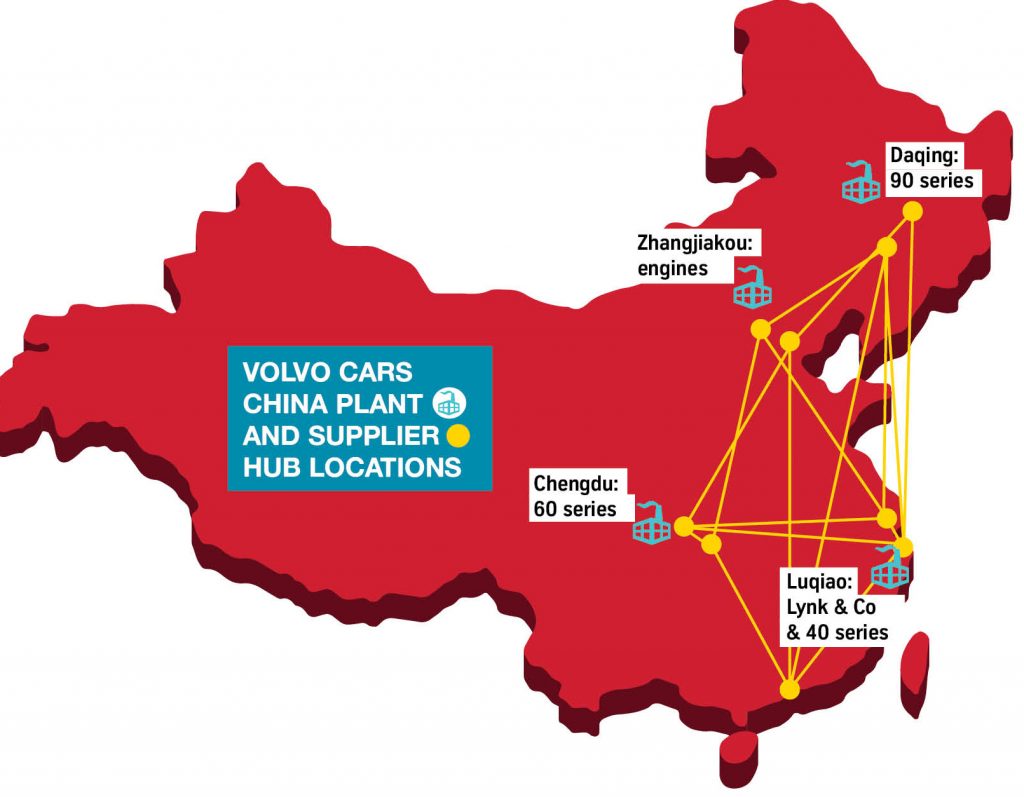 Click to enlarge
Click to enlargeFrom having just a handful of logistics staff focusing on inbound logistics when Volvo initially launched production in Chengdu in 2013 with the support of an LLP, Volvo Cars’ Asia Pacific inbound team now has more than 30 employees working across network planning, transport purchasing, route design, transport execution, freight cost and claims management, and logistics provider performance management.
“We now have flexibility and we can make small tweaks every week – because we should, but also because we can,” explains Ödling. “We have a strong standard process that secures that we run our network right and in a standard way for all our suppliers.”
An outbound team, led since December by Jamie Gaskell, covers a similar range of tasks across Volvo Cars’ distribution chain in China.
Having strong logistics control is important for Volvo Cars given the complexity of its Chinese supply chain, where plant locations and supplier clusters require long-distance exchanges of material across numerous transport modes. Chengdu, for example, where Volvo has both an assembly plant and an important supplier cluster, is 2,000km from the carmaker’s engine plant in Zhangjiakou, close to Beijing, and 3,000km from its plant in Daqing.
Across the inbound network for China, Volvo uses a mix of modes and intermodal transport, including coastal shipping of material between its supplier cluster in Shanghai and for the Daqing plant, as well as full and less-than-truckload trucking and consolidation; inland shipping is used along the Yangtze to Chengdu.
Currently, Volvo does not use rail as a regular service for domestic material; Ödling says the mode “lacks stability” in China, but it is used for ad hoc deliveries of material.
Though Volvo has added plants and installed a new set of logistics providers, Ödling points to a physical logistics network in China that is comparable to what it had previously under an LLP. For example, because of the major supplier clusters around the Shanghai area, as well as in Wuhan, along the Yangtze River, the carmaker had and still has consolidation centres there.
 "We now have flexibility and we can make small tweaks every week – because we should, but also because we can. We have a strong standard process the secures that we run our network right and in a standard way for all of our suppliers"- Magnus Ödling, Volvo Car Group
"We now have flexibility and we can make small tweaks every week – because we should, but also because we can. We have a strong standard process the secures that we run our network right and in a standard way for all of our suppliers"- Magnus Ödling, Volvo Car Group
The important development has been the carmaker’s ability to change quickly. Thanks to optimisation capabilities in the TMS, the logistics team monitors routing and milkruns that the system creates based on production schedules to ensure the right truckloads and frequencies are used.
“We don’t need to do this every hour, but each day we monitor that system-created bookings [transport orders] match demand,” Ödling says. “Likewise, if demand is changing we can, for example, switch to a smaller truck if that would be beneficial.”
Together with its TMS provider, Volvo has also developed a ‘dynamic milkrun’ function that allows it to define a region or group of suppliers, and to optimise trucking based on frequency and transport mode combinations for each day, whether that means one full truckload and two milkruns one day or vice-versa the next day. The performance for each of these modes and combinations is also tracked to benchmark cost and service.
While the frequency of changes varies, having the flexibility helps ensure a stable and efficient flow, especially during current periods of plant and product launches. “We want our team to check the system daily, and to talk to each other and react when they see things, such as a less-than-truckload shipment at 40 cubic metres,” Ödling says.
“That is the benefit of our having an in-house team: we’re here, we know the business, we care.”[sta_anchor id="3"]
A global flowThe management of Volvo’s international inbound logistics chain has also been an essential focus for the in-house team. As Volvo’s production network in China is still relatively new, and as it is producing more global models on the same platforms as European plants in Gothenburg, Sweden and Ghent, Belgium, the carmaker relies on a proportion of overseas, often common, components.
Volvo currently has around 300 suppliers in Europe serving its Chinese production; while this is around the same number it uses in China, imported content makes up a lower share of the supply chain at around 20% of inbound material by volume, according to Ödling (the proportion of China-sourced content for Lynk & Co at Luqiao will be significantly higher, however).
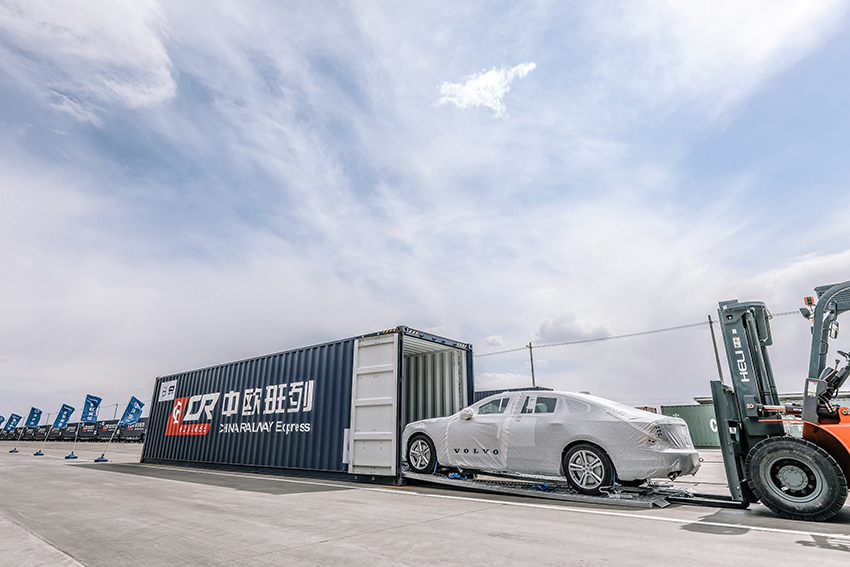 In a first for China-built cars, the Volvo S90, which began production in Daqing late last year, is being shipped to Europe via long-distance rail
In a first for China-built cars, the Volvo S90, which began production in Daqing late last year, is being shipped to Europe via long-distance railSimilar to its domestic inbound logistics, Volvo’s physical network has not changed radically for imported material, but it has benefitted from several new facilities and processes. For example, Volvo has added a second consolidation point in Europe, in Gothenburg, to complement the existing centre in Ghent. The carmaker has also added a number of direct shipments from high-volume suppliers, and it is looking for opportunities to add more during 2017. The team is also in the process of increasing the frequency of pick-up from European suppliers to support a reduction of storage space at the receiving plants.
The processing of global material is a demonstration of the way the in-house control and management of the inbound supply chain is also facilitating teamwork between the regions; the Volvo logistics teams in Europe manage all pre-carriage and container consolidation using the same global processes. Chinese supplier call-offs turn into transport orders from Volvo’s European arm. Containers move to the port of Dalian to reach its plant in the north, and to Shanghai, before travelling by inland vessel to Chengdu. For some time-sensitive material, Volvo has also run services by train between Europe and China, a mode which could increase now that Volvo will run a regular service for finished vehicles to Europe.
As with its domestic logistics, the benefits of insourcing come down to better visibility, improved communication and increased control over the supply chain. That has been particularly important given the multiple handoffs and parties involved for imported content. For example, parts sent through the port of Shanghai and then along the Yangtze to Chengdu need to be stored at the plant in containers until they are used. That has required Volvo to allocate space and infrastructure for storage and organise the reverse flow of empty containers.
“We have to arrange contracts with ocean carriers to allow us to keep containers until we unload them, before returning them – preferably as close as possible – to the unloading location,” says Ödling. “Considering our industrial footprint, this is an important aspect of the contracting that makes things more complicated.”
The global parts chain also faces plenty of risks. An ongoing port strike and lockout situation at the Swedish port of Gothenburg has caused significant challenges and risk of delay, and has required shipments to be re-directed to alternative ports of export or even modes of transport.
Restructuring in the global container shipping market has also led to service changes. According to Ödling, container lines recently started to treat the Europe-to-China route more as a ‘headhaul’ rather than a ‘backhaul’, which has increased rates and put more of a premium on obtaining space. Getting parts onto ships in good time is less guaranteed than it used to be.
But here, again, the integration of the new team and system has acted as a safeguard. Volvo has added the entire master dataset for parts and packaging into the TMS for the international chain – an element of the system that represented only a small function for European production – allowing clearer visibility on material locations and delivery performance. Volvo can make relatively fast decisions, such as expediting containers through the supply chain and switching from [sta_anchor id="4"]container shipping to rail.[related_topics align="right" border="yes"]
Scanning every momentNow that the inbound system has been running in China for nearly a year, Volvo is working on updates and improvements. It is investigating plans to increase the usage of returnable packaging, for example, as well as working on improvements to parts scanning and tracking.
One new feature for the TMS, currently in pilot phase, is the use of WeChat – by far most popular social media app in China – to record and track milestones. Drivers would use the app on their phones to register a shipment using a QR code scanner along direct routes and milkruns; once the shipment has been scanned, the smartphone’s GPS tracks exact locations of the truck and driver.
The app could also be used to photograph any damage or issues, as well as for Volvo to communicate directly with drivers from the TMS interface.
While Volvo already requires that its carriers and suppliers send it EDI notifications for each shipment, the way that logistics providers send messages varies widely. Some carriers use their own apps that scan directly into their own operations system and then directly via EDI to Volvo’s TMS; other providers communicate with their own back offices – whether through apps, phone calls or emails – which then send EDI messages to Volvo or enter it manually into the carmaker’s system.
Incorporating WeChat, which has nearly a billion users, most of them in China, could help standardise and automate these notifications. The app’s ubiquity would eliminate the variety of different equipment and the need to supply drivers with devices to communicate with Volvo’s system.
 "We have to arrange contracts with ocean carriers to allow us to keep containers until we unload them, before returning them... to the unloading location. Considering our industrial footprint, this is an important aspect of the contracting that makes things more complicated"- Magnus Ödling, Volvo Car Group
"We have to arrange contracts with ocean carriers to allow us to keep containers until we unload them, before returning them... to the unloading location. Considering our industrial footprint, this is an important aspect of the contracting that makes things more complicated"- Magnus Ödling, Volvo Car Group
“While the best carriers already provide automatic EDI messages, in some places we are suffering because the phone call or text message necessary to trigger the EDI isn’t happening or happens much later,” says Ödling. “If we can help carriers jump ahead, we can expand the size of the carrier market available to us.”
Such innovations should help to improve the reliability of data and visibility further. Ödling admits that his team won’t spend every minute watching truck locations, but that being able to see disruptions and exceptions in real time would be valuable.
Over time, more accurate pickup and shipping data will also help Volvo improve benchmarking across providers and suppliers.
As Volvo increases exports from China, opens a third assembly plant and launches further models, Ödling feels confident that his successor in China (yet to be named at the time of writing) will inherent a stable logistics network. New technology and updates to the TMS will improve visibility further; closer relations with carriers are also supporting operational improvements, including those that can be written into new contracts in the coming years.
The system will also be well placed to handle further growth across Asia Pacific. Geely’s recent investment in Malaysian carmaker Proton, for example, could lead to an even more complex footprint in future.
For now, Ödling is perhaps most impressed with the increasing maturity in the logistics team’s handling of changes and disruptions since it went into full action last autumn.
“After you have been through ten fires, you are less nervous for the 11th. We have kept our cool, and we are able to react as quickly as we can,” he says.











